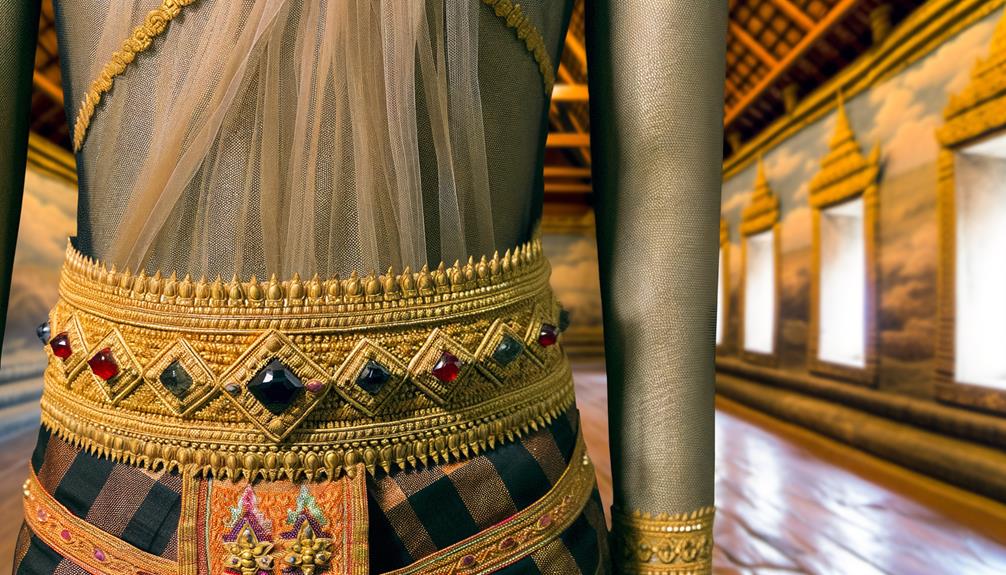Girdle Meaning In The Bible: Truth and Readiness
In biblical texts, the girdle is both a practical garment and a significant symbol. Originally designed to secure loose clothing for ease of movement and to carry tools or weapons, it evolved to symbolize strength, readiness, and integrity.
Within scriptural contexts, it often denotes divine empowerment and preparedness, emphasized in metaphors like the “girdle of truth” which underscores the importance of righteousness and steadfastness. Prophetic writings use the girdle to convey spiritual readiness and commitment to divine purposes, encapsulating broader theological themes of purity, authority, and divine protection.
For deeper insights into its varied symbolism and applications, consider the broader scriptural context.

Girdle Meaning in the Bible: Symbol of Strength, Readiness, and Truth
| Aspect | Biblical Insight |
|---|---|
| Definition | A belt or sash, often used to secure garments and symbolize preparation |
| Old Testament Reference | Isaiah 11:5 – “Righteousness will be his belt and faithfulness the sash…” |
| New Testament Reference | Ephesians 6:14 – “Stand firm… with the belt of truth buckled around your waist” |
| Symbolism | Truth, strength, faithfulness, and readiness for spiritual duty |
| Spiritual Application | Encourages believers to live in truth and be prepared for spiritual warfare |
Girdle in Ancient Times

In ancient times, the girdle was an essential and multifunctional garment that held both practical and symbolic significance across various cultures.
This versatile item, often crafted from materials such as leather, cloth, or metal, served to secure loose clothing, facilitating ease of movement and physical labor. Additionally, girdles often functioned as a means of carrying tools or weapons, underscoring their utility in daily tasks and combat.
Beyond their practical applications, girdles frequently bore intricate designs, indicating social status and cultural identity. In religious contexts, the girdle carried profound connotations, sometimes denoting authority or sanctity.
Understanding the multifaceted roles of the girdle in ancient societies provides valuable insights into its deeper meanings and continued presence in historical texts, including the Bible.
Symbol of Strength

Beyond their practical and cultural functions, girdles in biblical texts often symbolize strength, reflecting their role in ancient societies as indispensable items that provided physical support and conveyed power.
This symbolism is evident in various scriptural passages where girdles are associated with preparedness, resilience, and divine empowerment. The girdle’s ability to secure other garments and tools underscores its metaphorical representation of readiness and capability.
| Aspect | Biblical Significance |
|---|---|
| Physical Support | Essential for daily activities |
| Conveying Power | Symbol of authority |
| Divine Empowerment | Sign of God’s strength |
In essence, the girdle encapsulates the essence of strength, both physical and spiritual, serving as a tangible reminder of the virtues of steadfastness and preparedness in the biblical narrative.
Girdle in Warfare

Integral to the attire of ancient warriors, the girdle in biblical warfare served not only as a practical tool for securing weapons and armor but also as a symbol of martial readiness and divine protection.
Functionally, the girdle allowed soldiers to carry swords and other essential equipment, facilitating ease of movement and accessibility in battle.
Contextually, it represented a warrior’s preparedness and commitment, often imbuing the wearer with a sense of divine favor and strength.
Scriptural references, such as in Isaiah 11:5 and Ephesians 6:14, highlight the girdle as emblematic of truth and righteousness, reinforcing its dual role in both physical and spiritual combat.
Consequently, the girdle was a crucial component of a warrior’s ensemble, merging utility with symbolic significance.
Priestly Garments

Central to the sacred duties of the ancient Hebrew priests, the girdle was an essential element of their ceremonial attire, symbolizing purity, consecration, and divine service.
In the context of the priestly garments described in Exodus 28:4, the girdle, referred to as the ‘sash’ or ‘belt,’ was intricately woven and adorned with fine linen and blue, purple, and scarlet yarns.
This garment was not merely functional; it held profound theological significance, delineating the wearer’s role as a mediator between God and the people.
Serving as a physical and symbolic binding, the girdle reinforced the priest’s commitment to their sacred duties and separation from the profane, underscoring the sanctity and dedicated nature of their divine vocation.
Girdle of Truth

In the New Covenant, the ‘girdle of truth’ referenced in Ephesians 6:14 symbolizes the foundational role of truth in the spiritual armor of a Christian, underscoring the necessity of integrity and righteousness in the believer’s life. This metaphorical girdle serves as the first piece of armor, emphasizing that truth is crucial for spiritual warfare and moral fortitude.
Biblical Foundation: Truth serves as a cornerstone in biblical teachings, reinforcing the believer’s commitment to God’s word.
Moral Integrity: It signifies honesty and transparency, essential for authentic Christian living.
Spiritual Protection: Truth fortifies against deception and falsehoods, offering spiritual security.
Inner Strength: It enhances the believer’s resolve and conviction, crucial for enduring trials and temptations.
Spiritual Readiness

In biblical theology, the girdle serves as a potent symbol of spiritual readiness, emphasizing the necessity of preparation and vigilance in one’s faith journey.
As part of the Armor of God, the girdle, or belt, underscores the importance of truth and righteousness, providing a foundational element for the believer’s defense against spiritual adversities.
This metaphorical ‘girding up’ illustrates the call for Christians to be perpetually equipped and steadfast in their faith.
Symbol of Preparation
The girdle in biblical texts often symbolizes a state of readiness and preparedness, particularly in a spiritual context. This emblem of readiness is frequently invoked to underline the importance of being spiritually vigilant and morally steadfast.
The girdle, through its practical use in ancient times for securing one’s garments, metaphorically underscores the necessity for believers to be always prepared for spiritual endeavors and challenges.
- Spiritual Vigilance: The girdle represents the need for constant awareness and alertness in one’s faith journey.
- Moral Integrity: It signifies the need to uphold truth and righteousness as foundational principles.
- Discipline and Order: Just as a girdle organizes garments, it implies the importance of a disciplined spiritual life.
Armor of Faith
Building upon the symbolism of preparedness, the girdle also plays an essential role in the metaphorical ‘Armor of Faith,’ representing spiritual readiness and resilience against moral and existential challenges.
In Ephesians 6:14, the Apostle Paul refers to the ‘belt of truth‘ as a foundational element of the spiritual armor. This girdle signifies the believer’s commitment to integrity and truthfulness, acting as a safeguard against deception and moral compromise.
Contextually, the girdle’s practical function in securing one’s garments for action parallels the spiritual need for steadfastness and vigilance. Consequently, it embodies the preparedness essential for confronting spiritual adversities, ensuring that the faithful remain anchored in their convictions and equipped to uphold their moral fortitude.
Girdle in Prophecy

Prophetic texts frequently employ the girdle as a symbolic element to convey messages of preparation, strength, and divine truth. The girdle, often worn by prophets, underscores readiness and the fortitude required to fulfill divine mandates. Its symbolic import can be analyzed through various scriptural instances:
Jeremiah’s Linen Girdle: Demonstrates the relationship between Israel and God, emphasizing purity and eventual corruption (Jeremiah 13:1-11).
Isaiah’s Prophecy: The girdle of righteousness and faithfulness signifies the Messiah’s just rule (Isaiah 11:5).
Elijah’s Leather Girdle: Represents austere living and prophetic authority (2 Kings 1:8).
Ephesians’ Armor of God: The ‘belt of truth’ signifies preparedness and integrity in spiritual warfare (Ephesians 6:14).
These instances illustrate the girdle’s profound prophetic symbolism in biblical literature.
Metaphors in Scripture
In examining the metaphors in Scripture, the girdle emerges as a multifaceted symbol that encapsulates themes of preparation, readiness, and divine truth.
Its presence in prophetic texts underscores its role not just as a physical garment but as a spiritual emblem, often carrying deeper theological and moral significance.
Symbolism of Girdles
The girdle in biblical scripture often serves as a powerful metaphor for readiness, truth, and spiritual fortitude, symbolizing the preparedness and integrity of the faithful. This symbolic usage is deeply rooted in cultural and historical contexts, reflecting the girdle’s functional role in ancient attire.
- Readiness for spiritual combat: Ephesians 6:14 emphasizes the ‘belt of truth,’ representing the believer’s preparedness against spiritual adversaries.
- Truth and sincerity: The girdle, tightly fastened, signifies holding fast to truth and integrity.
- Service and humility: John 13:4-5 illustrates Jesus wrapping a towel around His waist, symbolizing servitude and humility.
This analysis underscores the girdle’s multifaceted symbolism within scripture.
Girdles in Prophecy
Building upon the symbolic significance of girdles, their prophetic usage in scripture further enriches their metaphorical resonance, often conveying divine messages and foretelling pivotal events.
For instance, in Jeremiah 13:1-11, the prophet is commanded to wear and then bury a linen girdle, symbolizing Israel’s impending exile and spiritual decay.
Similarly, Isaiah 11:5 uses the metaphor of a girdle to describe righteousness and faithfulness as the belt worn by the Messianic figure.
These instances highlight the girdle as a powerful prophetic device, embodying themes of preparation, judgment, and divine authority.
The use of girdles in prophecy underscores their role in illustrating moral and spiritual truths, enhancing our comprehension of biblical narratives and their theological implications.
Spiritual Significance Explained
Through examining the spiritual significance of girdles in biblical texts, one can discern how these metaphors elucidate deeper theological themes and moral precepts. Girdles, often symbolizing preparedness and truth, serve as profound metaphors within scripture, enriching the believer’s spiritual journey. They embody not merely physical readiness but a state of spiritual alertness and moral rectitude.
Truth and Integrity: Ephesians 6:14 describes the ‘belt of truth,’ symbolizing sincerity and honesty.
Preparedness for Service: In 1 Peter 1:13, girding the loins of the mind signifies readiness for spiritual endeavors.
Strength and Protection: Isaiah 11:5 likens righteousness and faithfulness to a girdle, emphasizing divine strength.
Unity and Commitment: Jeremiah 13:11 uses the girdle to illustrate Israel’s closeness to God, stressing covenantal fidelity.
Lessons for Today

Understanding the symbolic significance of the girdle in biblical texts can offer valuable insights for contemporary spiritual and ethical practices. The girdle, often symbolizing readiness and truth, underscores the importance of being prepared and honest in our daily lives.
Emulating the biblical emphasis on integrity and preparedness can enrich personal growth and community interactions. The girdle’s role in priestly attire also highlights the necessity of devotion and righteousness for those in leadership.
Conclusion
The girdle in biblical texts serves as a multifaceted symbol, embodying strength, readiness, and divine truth.
From ancient warfare to priestly garments, this humble accessory transcends its material form to represent spiritual preparedness and moral integrity.
As a metaphor, the girdle underscores the importance of being fortified both physically and spiritually.
In contemporary context, the lessons drawn from its symbolism urge adherence to ethical principles, reinforcing the timeless relevance of these ancient teachings.






